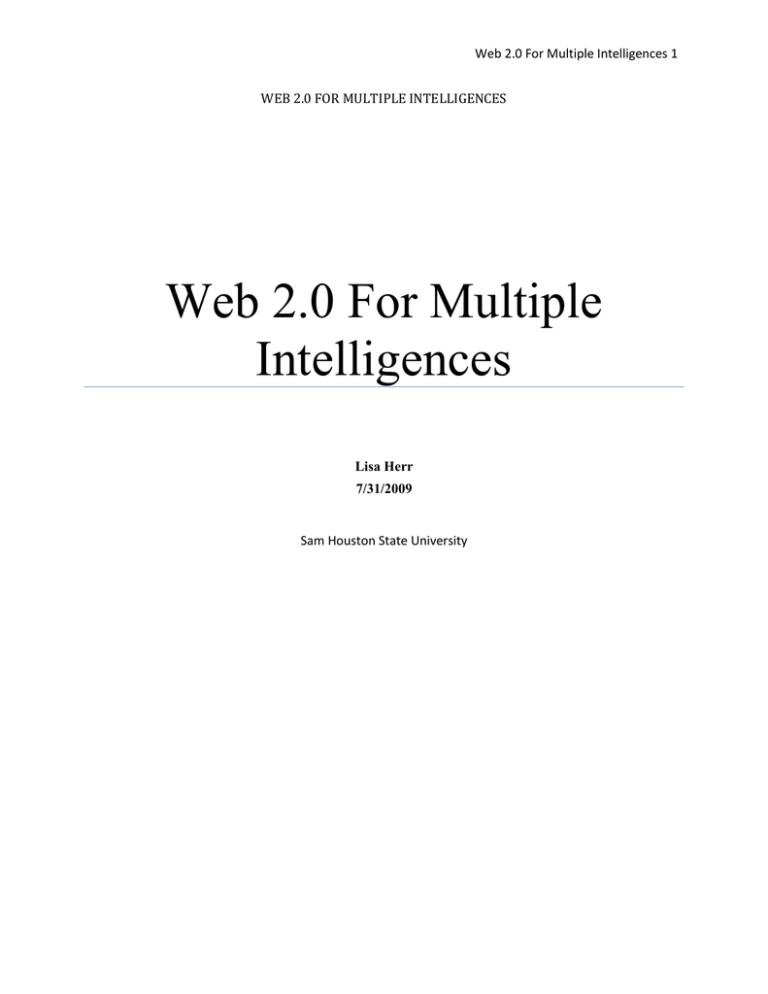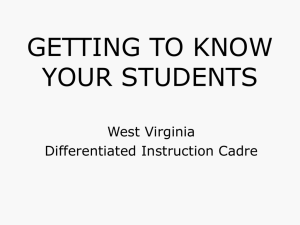Web 2.0 For Multiple Intelligences - Lisa Herr - home
advertisement

Web 2.0 For Multiple Intelligences 1 WEB 2.0 FOR MULTIPLE INTELLIGENCES Web 2.0 For Multiple Intelligences Lisa Herr 7/31/2009 Sam Houston State University 2 ABSTRACT Teachers in today’s society are called to higher and more stringent standards regarding technology. Over the last several years technology immersion has become a driving component in education. Teachers are not only expected to have expertise in subject matter content, but are required to provide instruction and student opportunities that meet the goals of the state, school districts, and national technology initiatives. The advent of Web applications, known collectively as Web 2.0 tools, supports these goals. Many Web 2.0 tools are available that not only facilitate meetings standards, but target the multiple intelligences of the learner. Web 2.0 ensures engaging, energetic, and exciting learning. 3 Teachers in today’s society are called to higher and more stringent standards regarding technology. Over the last several years technology immersion has become a driving component in education. Teachers are not only expected to have expertise in subject matter content, but are required to provide instruction and student opportunities that meet the goals of the state, school districts, and national technology initiatives. The advent of Web applications, known collectively as Web 2.0 tools, supports these goals. For example, words used to defines the NETS for Students, include; interact, collaborate, publish, variety of digital environments, communication, produce original works, solve problems, responsible use of information, learning, productivity, digital citizenship, select and use applications (International Society for Technology Education, 2007). According to Donna Baumbach, in Web 2.0 & You, integrating Web 2.0 into curriculum and instruction allows educators to; “move students beyond searching for information to using it and creating it,” “get better results from student projects and research;” “provide more equitable access to digital tools and resources;” “integrate 21st Century skills into curriculum;” “foster more collaboration;” and “do more in less time” (Baumbach, 2008, p. 13). One Utipu.com allows users to capture video of their screen and record voice to create a video for instruction. The user can save the video and share the video with others. Their tagline, “See What I’m Saying,” is perfect in defining Utipu’s purpose: A tool that allows teachers to target the visual intelligence of learners. Teachers can use this resource for instructional purposes by creating a video lesson with narration. Students can benefit by creating videos or conducting a lesson of their own. Utipu.com targets the visual, verbal, kinesthetic, interpersonal, and naturalist intelligences of learners. A fundamental premise in “brain-based learning” is the creation of a 4 learning environment that is challenging to the learner, yet does not pose a threat. This allows the learner to participate confidently and derive personal meaning in the learning experience (Caine & Caine, 1990, p.69). A teacher can facilitate “relaxed alertness” by providing clear instructions and various resources to learners. Two Animoto.com is a tool to create hip videos from pictures. You are able to upload pictures, choose music from their library, and add text, much like features available in Movie Maker. However, Animoto.com automatically generates the video and places special effects for you making the process of creating a video less intensive. You are able to share your video creations with others via invitation or by uploading the video to YouTube. I created a short video, ShaneSkim Board Master, which is viewable on YouTube. Integrating a tool such as Animoto.com, targets the visual, musical, intrapersonal, and existential intelligences of learners. Three Sketchcaste.com captures screen shot of the user making a drawing. You may add narration and create a video. This would be a great presentation tool for instructional purposes, as well as a fun way for students to create videos for projects. Integrating this Web tool into curriculum targets the verbal, visual, musical, kinesthetic, intrapersonal, and naturalist intelligences of students. Four YackPack is a tool for setting up a “Virtual Office”, or in the case of education, a “Virtual Classroom.” YackPack would allow students to participate in discussions, ask peers questions, 5 and provide feedback without leaving the workstation. This would also be a great tool for teachers to collaborate on ideas and generally stay connected through the day. As teachers, we are often isolated from our peers for a good portion of the day. YackPack.com offers a great way to encourage relationships and unity in spirit. Integrating YackPack into instruction targets the verbal, visual, interpersonal, and existential intelligences of students. Five Greenopolis.com includes links to informative videos and articles regarding “Green” living and educational interactive games. I played the Ecological Footprint game and loved it. Apparently it would take 4.7 planets to sustain living if everyone lived as I did. Yikes! The game provides information on ways that you can change your ecological footprint. In addition, the website offers information on ways students can get involved and compete with other students to make our planet more sustainable. Socially responsibility is prevalent in all 6 facets of today’s society. Corporations have adopted Social Responsibility statements published within their Annual Reports, consumers make choices surrounding social concerns mandated by companies, social sectors emerge with driving concerns for various causes, and college entrance requires students’ participation in community service efforts. Integrating social responsibility into curriculum fosters the development of a 21st Century mind-set students need to succeed in the future. Integrating resources such as Greenopolis.com not only targets many of the intelligences defined by Gardner’s multiple intelligence theory, including; verbal, logical, visual, musical, intrapersonal, interpersonal, and existential intelligences, it also highlights the social purpose for learning. Six VisualWords.com is one of the most exciting tools that I discovered in my journey. Visuawords is an online graphical dictionary. It allows the user to look up words to find their meanings and links to other words and concepts. Visuawords.com uses the Princeton University’s WordNet which is an open-source database built by university students. There is no membership required to use Visuawords.com. The words and links are color coded. The Visuawords Web tool provides synonyms, hyponyms, hypernym pairs, meronyms, and holonym pairs. This is truly an amazing Web tool and a “must see.” Integrating Visuawords.com into instruction targets the visual , naturalist, and verbal intelligences of learners. According to New Brain Research, the brain assimilates meaning through patterning. The brain naturally opposes isolated and unrelated pieces of information (Cain & Caine, 1990, p.67). Utilizing VisuaWords.com as an instructional tool allows the learner to visual see the connections of information. 7 Seven Kartoo.com is another research oriented Web tool that is a “must see.” The user is able to enter any subject matter into the search bar and a plethora of information is immediately available to the user. The screen is divided into several quadrants providing different information regarding a topic. The search produces links to latest news, images, and reference materials. KartOO.com targets verbal, logical, visual, kinesthetic, and naturalist intelligences of learners. This is a powerful tool for initiating research. The possibilities for educators are endless. 8 Eight Learner.org Interactives, located on the World Wide Web at http://www.learner.org/interactives, provides teachers with a wealth of interactive tutorials on various subjects, including; DNA, the Periodical Table, Story Elements, Renaissance Period, History Interactives, Math in Everyday Life, Literature, Historical and Cultural Contexts, and more. The user can view online tutorials, participate in interactive activities, and take an 9 interactive quiz on any subject. The interaction provided by Learner.org Interactives targets the kinesthetic intelligence of learners. New Brain Research indicates that focusing too much on rote memory “is a very inefficient use of the brain” and leaves the learner deprived (Caine & Caine, 1990, p. 68). Teachers implementing embedding strategies utilize a learners’ spatial memory and fosters greater understanding and recall. Embedding can be accomplished by “immersing the learner in a multitude of complex and interactive experiences” (p. 69). Web tools such as Learner.org Interactives, provides a forum for learners to plunge right in to such an immersive learning environment. Nine Quizlet.com is an interactive Web site offering information, flashcards, games, and interactive quizzes on various subjects. The database of available resources is huge. Every subject area is represented, as well as, preparatory material for standardized tests such as GRE, GMAT, PSAT, and SAT. I actually used the GRE vocabulary resources and loved the interactivity. I first was able to familiarize myself with the vocabulary terms, and then I played several different interactive games covering the GRE vocabulary. In addition to the database, the user is able to create flashcards and quizzes to share with others. Quizlet.com would be a great resource for teachers as well as students. Teachers could create lessons that students could access. Students could create lessons and share with their peers. The Web tool is also testing new resources involving voice. Depending on the lab inventory of the school, the voice component may or may not be available to the user. However, students that have computer and internet access at home could use the voice oriented games for reinforcement of classroom instruction. Quizlet.com targets visual, verbal, and kinesthetic intelligences of learners. 10 New Brain research reminds educators that abilities develop over time. Educators “should focus on the process of learning rather than on performance” (Hinton, Miyamoto, &DellaChiesa, 2008, p. 88). One key teaching strategy educators use to emphasize this is using formative assessments. Several components are essential in creating formative assessment strategies, including; “ a focus on learning rather than performance”; a “transparent learning process”; “varied instructional methods”; “variety of assessment techniques”; and “frequent feedback through the learning process” (p.90). Quizlet.com assists educators in creating positive formative assessments including interactive games providing frequent feedback to the learner. In additions, Quizlet.com provides a variety of instructional methods increasing the likelihood of student achievement. Ten Last, but certainly not least, Wikispaces.com offers tools educators can use for class collaborative efforts. Students are able to collaborate with others, participate in discussions, and share work product. Wikispaces.com is currently offering educators in the K-12 arena the ability to create a private community for classroom collaboration for free. Many college environments already successfully utilize wikis for class discussions and group work. Utilizing Wiki has been an issue in the past for K-12 teachers due to stringent filtering by school districts and the necessity to keep children from on-line harm. Wiki is working on ways to help K-12 educators overcome these obstacles and utilize this fabulous tool safely. Wikispaces.com targets the visual, verbal, musical, intrapersonal, interpersonal, and existential intelligences of learners. New Brain Research highlights that motivation is fundamental to learning. Two ways educators can motivate learners on an intrinsic level, is to promote learner autonomy and 11 relatedness. Teachers can support autonomy by creating a sense of community and social connectedness (Hinton, et al, 2008, p. 92). Wikispaces.com cultivates this sense of community providing a safe place to collaborate, debate, discuss, and share. 12 Baumbach, D. 2009. Web 2.0 & You, Knowledge Quest, 37 (4) March/ April 2009, pp 12-19, Retireved from the World Wide Web July 31, 2009 http://www.pbs.org/teachers/librarymedia/aasl/baumbach.pdf . Caine, R., & Caine, G. (1990, October). Understanding a brain-based approach to Learning and teaching. Educational Leadership, 48(2), 66. Retrieved July 10, 2009, from Academic Search Complete database. College@home.com, 2009, 100 Helpful Web Tools For Every Kind Of Learner, Retrieved from the World Wide Web July 31, 2009 http://www.collegeathome.com/blog/2008/06/10/100-helpful-web-tools-for-every-kindof-learner . HINTON, C., MIYAMOTO, K., & DELLA-CHIESA, B. (2008, March). Brain Research, Learning and Emotions: implications for education research, policy and practice. European Journal of Education, 43(1), 87-103. Retrieved July 11, 2009, doi:10.1111/j.1465-3435.2007.00336.x International Society for Technology in Education. 2007. NETS for Students 2007. Retrieved from the World Wide Web July 31, 2009 www.iste.org/Content?navigationMenu/NETS/ForStudents/2007Standards/NETS_for_st udents_2007.htm .







